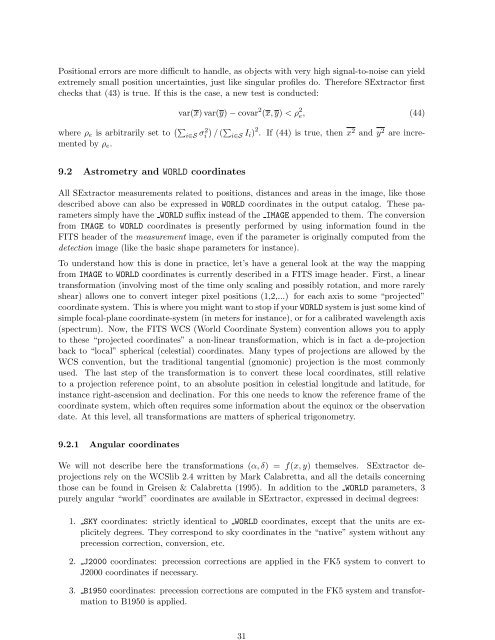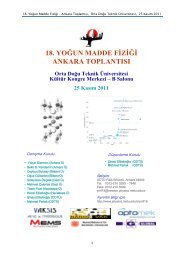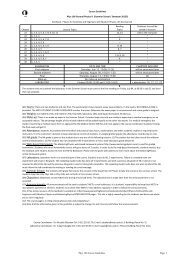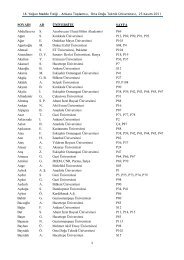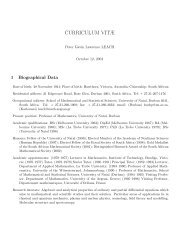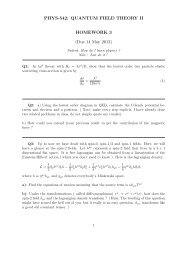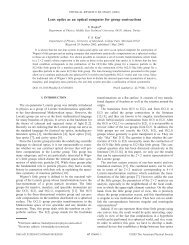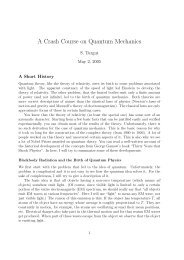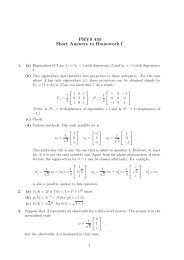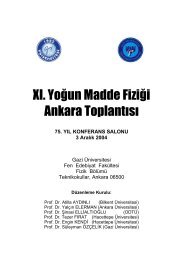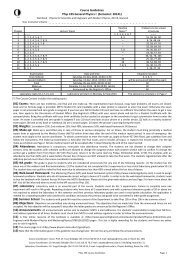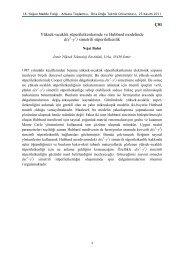SExtractor Draft - METU Astrophysics
SExtractor Draft - METU Astrophysics
SExtractor Draft - METU Astrophysics
- No tags were found...
You also want an ePaper? Increase the reach of your titles
YUMPU automatically turns print PDFs into web optimized ePapers that Google loves.
31Positional errors are more difficult to handle, as objects with very high signal-to-noise can yieldextremely small position uncertainties, just like singular profiles do. Therefore <strong>SExtractor</strong> firstchecks that (43) is true. If this is the case, a new test is conducted:var(x) var(y) − covar 2 (x, y) < ρ 2 e, (44)where ρ e is arbitrarily set to (∑ ) ∑i∈S σ2 i / ( i∈S I i) 2 . If (44) is true, then x 2 and y 2 are incrementedby ρ e .9.2 Astrometry and WORLD coordinatesAll <strong>SExtractor</strong> measurements related to positions, distances and areas in the image, like thosedescribed above can also be expressed in WORLD coordinates in the output catalog. These parameterssimply have the WORLD suffix instead of the IMAGE appended to them. The conversionfrom IMAGE to WORLD coordinates is presently performed by using information found in theFITS header of the measurement image, even if the parameter is originally computed from thedetection image (like the basic shape parameters for instance).To understand how this is done in practice, let’s have a general look at the way the mappingfrom IMAGE to WORLD coordinates is currently described in a FITS image header. First, a lineartransformation (involving most of the time only scaling and possibly rotation, and more rarelyshear) allows one to convert integer pixel positions (1,2,...) for each axis to some “projected”coordinate system. This is where you might want to stop if your WORLD system is just some kind ofsimple focal-plane coordinate-system (in meters for instance), or for a calibrated wavelength axis(spectrum). Now, the FITS WCS (World Coordinate System) convention allows you to applyto these “projected coordinates” a non-linear transformation, which is in fact a de-projectionback to “local” spherical (celestial) coordinates. Many types of projections are allowed by theWCS convention, but the traditional tangential (gnomonic) projection is the most commonlyused. The last step of the transformation is to convert these local coordinates, still relativeto a projection reference point, to an absolute position in celestial longitude and latitude, forinstance right-ascension and declination. For this one needs to know the reference frame of thecoordinate system, which often requires some information about the equinox or the observationdate. At this level, all transformations are matters of spherical trigonometry.9.2.1 Angular coordinatesWe will not describe here the transformations (α, δ) = f(x, y) themselves. <strong>SExtractor</strong> deprojectionsrely on the WCSlib 2.4 written by Mark Calabretta, and all the details concerningthose can be found in Greisen & Calabretta (1995). In addition to the WORLD parameters, 3purely angular “world” coordinates are available in <strong>SExtractor</strong>, expressed in decimal degrees:1. SKY coordinates: strictly identical to WORLD coordinates, except that the units are explicitelydegrees. They correspond to sky coordinates in the “native” system without anyprecession correction, conversion, etc.2. J2000 coordinates: precession corrections are applied in the FK5 system to convert toJ2000 coordinates if necessary.3. B1950 coordinates: precession corrections are computed in the FK5 system and transformationto B1950 is applied.


